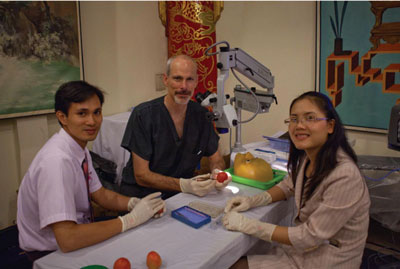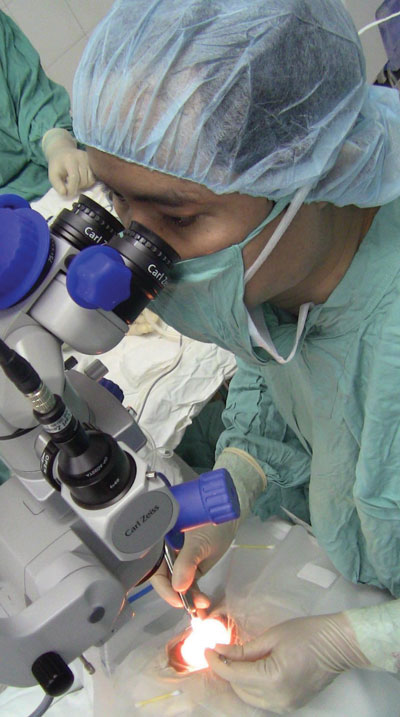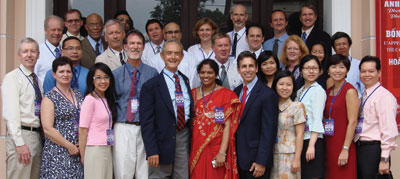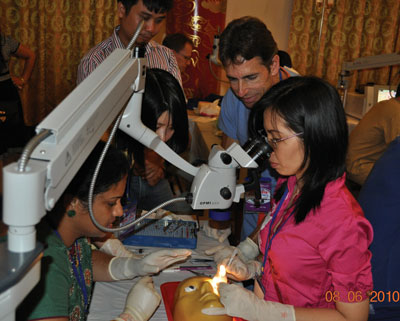2010 Imperial City Eye Meeting trains Vietnamese ophthalmologists
More than 400 eye doctors received training in treatment of cataract, corneal and retinal disease, ocular reconstructive surgery, and glaucoma diagnosis and treatment.
Hue, a friendly and colorful city located on the Perfume River in central Vietnam, was host to the third biennial Imperial City Eye Meeting in June. According to its organizers, this event was the largest meeting of ophthalmologists ever held in Southeast Asia. The Hue Festival 2010 was held concurrently and gave meeting participants an opportunity to experience the cultural highlights of this vibrant country.
The Imperial City Eye Meeting (ICEM) is the brainchild of John M. Corboy, MD, president of the Hawaiian Eye Foundation, and Pham Vinh Tuyen, MD, vice chairman of the department of ophthalmology at the Hue Central Hospital, and for the third time since 2006, these two men co-directed this popular meeting.
About the meeting
This year, 425 Vietnamese eye doctors from Ho Chi Minh City (Saigon), Hanoi, Da Nang and other parts of the country came to learn from 30 eye specialists from the U.S., Canada, the United Kingdom, Germany, India, Singapore and Vietnam. This is nearly double the number of participants and faculty present at the first meeting, a testament to its educational value. Considering that Vietnam has fewer than 900 ophthalmologists for a population of more than 85 million people, the level of attendance was excellent.
The program included training in treatment of cataract, corneal and retinal disease, ocular reconstructive surgery, and glaucoma diagnosis and treatment. Daily lectures were simultaneously translated into Vietnamese. Concurrent wet lab sessions offered individualized surgical instruction in phacoemulsification and manual small-incision cataract surgery, with plenty of pigs’ eyes on hand for copious practice. A dry lab was also run for the educational benefit of the participants, emphasizing training in state-of-the-art laser and imaging systems. U.S. and Asian equipment, instrument and pharmaceutical companies also exhibited their products.
Participants were not charged to attend the 4-day conference, made possible through the generous donations of 15 commercial and foundation exhibitors. Volunteer faculty members paid for their own travel and accommodation expenses. The faculty was privileged to have ophthalmology residents from both the University of Toronto and Oregon Health and Science University present for the meeting. These residents built relationships with residents from the Hue Central Hospital and were able to observe the differences in training methods compared with those in North America.
 Kerry Hagen, MD, teaches Vietnamese students the art of capsulorrhexis. Image: Hagen K |
 Pham Vinh Tuyen, MD, performs phacoemulsification during the SEE International sponsored surgery program after the meeting. Image: Gattey D |
 The faculty from the 2010 Imperial City Eye Meeting. Image: Hawaiian Eye
Foundation |
 Ghanta Madhavi, MD, and Jeff Rutgard, MD, teach Vietnamese doctors manual small-incision cataract surgery in a wet lab. Image: Kutumbaka M |
Training expedition
The nonprofit Hawaiian Eye Foundation promotes ICEM in coordination with Vietnamese partners, corporate sponsors and nongovernmental organizations (NGOs). The charitable foundation has conducted humanitarian eye care and training expeditions in the Pacific Rim for more than 25 years, especially in Tonga, Fiji and Samoa.
Jeff Rutgard, MD, is the treasurer of the Hawaiian Eye Foundation and its most active member in surgical outreach activities. He is an experienced surgeon who has performed several thousand manual small-incision cataract surgeries in clinics all over the developing world.
“We are able to effectively train more people in Vietnam than in any other country that I have worked in. Their gratitude is awesome, and it was great to be here,” Dr. Rutgard said about this year’s meeting.
One of the NGOs that sponsored ICEM was Surgical Eye Expeditions (SEE) International, which provided most of the disposable supplies for the wet lab. In addition, it sponsored a surgical program at the Hue Central Hospital after the meeting.
As a member of SEE International and the Hawaiian Eye Foundation Scientific Advisory Board, I was honored to guide this effort, working with faculty surgeons from the hospital. Over the course of 5 days, we provided 88 sight-restoring surgeries. I especially enjoyed the teaching that went on inside the operating rooms. With permission from Brian Little, MD, and his group, I was able to utilize the fantastic teaching videos of the Video Atlas of Eye Surgery during my lectures at ICEM, and then, during the SEE International surgical expedition, I reinforced the lessons by demonstrating on our patients. The surgeries were projected onto a large flat screen monitor, and several Vietnamese ophthalmologists watched the action.
Need for education
The need for high-level ophthalmic education in Vietnam is great.
“I think that all of the ICEM faculty were impressed with the urgency of the need for improved eye surgical expertise in Vietnam and the eagerness of Vietnamese ophthalmologists to learn,” Dr. Corboy said.
Only 10 ophthalmologists are available for every 1 million Vietnamese, and most ophthalmologists practice in larger cities. In rural areas, health workers are usually nurses or technicians who have minimal instruction in eye care and negligible resources for blindness prevention and treatment. The majority of Vietnam’s more than half million blind people reside in the countryside, according to Orbis International, which also supported ICEM.
In an effort to meet the eye care needs of these citizens, the Hawaiian Eye Foundation and its partners will continue to support this groundbreaking meeting. The next Imperial City Eye Meeting is scheduled for April 2012 in Hue City, Vietnam, and faculty positions are available.

- Devin Gattey, MD, Clinical Associate Professor of Ophthalmology, is the Director of Comprehensive Ophthalmology at the Casey Eye Institute. He can be reached at Center for Health and Healing, 3303 SW Bond Ave., Portland, OR 97239; e-mail: gatteyd@ohsu.edu.
- The Hawaiian Eye Foundation can be reached at www.hawaiianeyefoundation.org.
- Surgical Eye Expeditions (SEE) International can be reached at www.seeintl.org.
